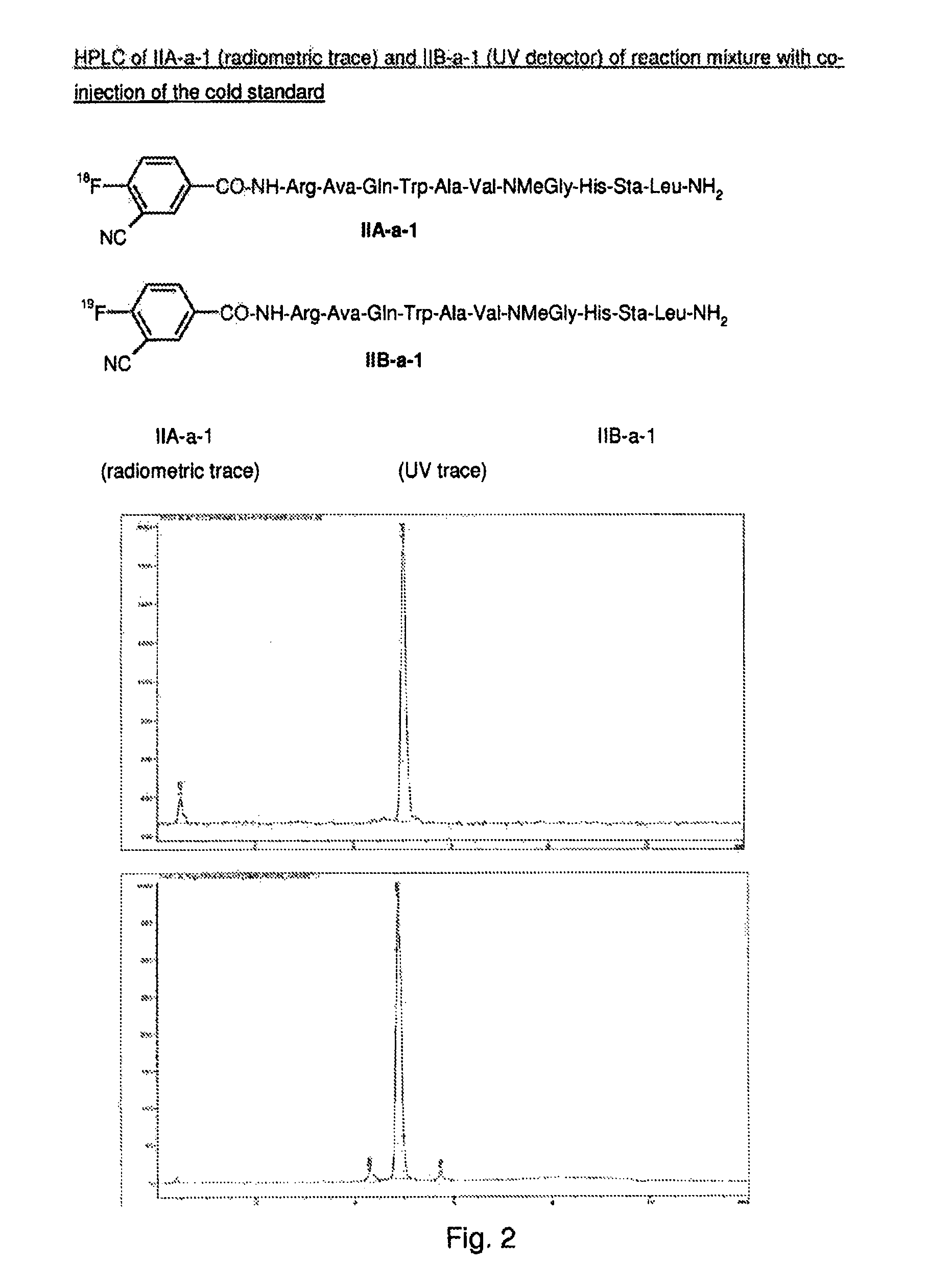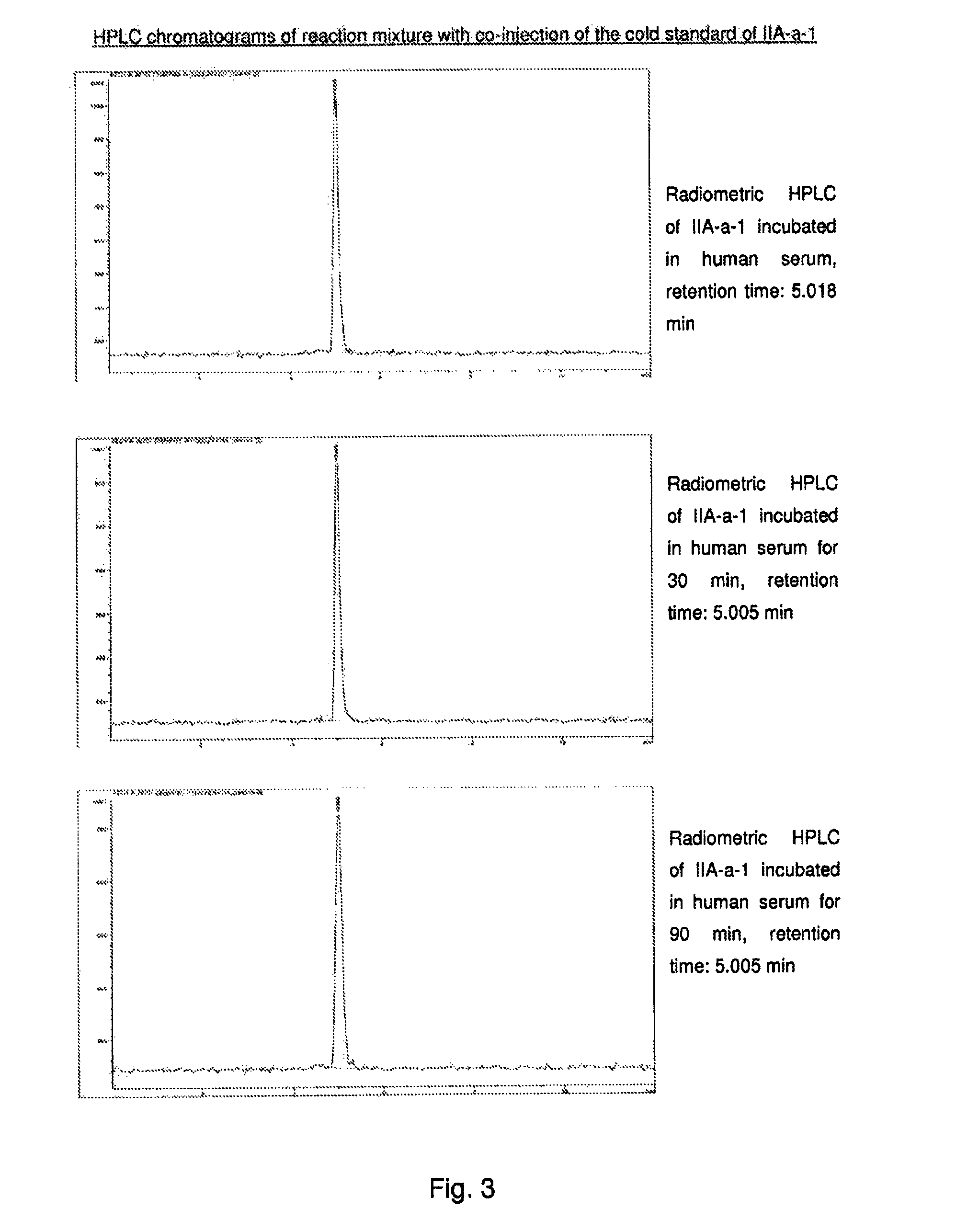Compounds and methods for 18F labeled agents
a labeling agent and compound technology, applied in the field of compounding, can solve the problems of laborious and time-consuming preparation of the sup>18/sup>f labeling agent, unwanted physiologic effects and chelate attachment, and labeling peptides with sup>
- Summary
- Abstract
- Description
- Claims
- Application Information
AI Technical Summary
Benefits of technology
Problems solved by technology
Method used
Image
Examples
first example
[0501]18F-fluoride (up to 40 GBq) was azeotropically dried in the presence of Kryptofix 222 (5 mg in 1.5 ml MeCN) and cesium carbonate (2.3 mg in 0.5 ml water) by heating under a stream of nitrogen at 110-120° C. for 20-30 minutes. During this time 3×1 ml MeCN were added and evaporated. After drying, a solution of the precursor (2 mg) in 150 μl DMSO was added. The reaction vessel was sealed and heated at 50-70° C. for 5-15 mins to effect labeling. The reaction was cooled to room temperature and dilute with water (2.7 ml). The crude reaction mixture was analyzed using an analytical HPLC. The product was obtained by preparative radio HPLC to give to desired 18F labeled peptide.
second example
[0502]Model compounds and peptides containing unnatural Histidine analogues
[0503]18F-fluoride (up to 100 GBq) was azeotropically dried in the presence of Kryptofix 222 (5 mg in 1.5 ml MeCN) and potassium carbonate (1 mg in 0.5 ml water) or cesium carbonate (2.3 mg in 0.5 ml water) by heating under nitrogen at 100-120° C. for 20-30 minutes. During this time 2−3×1 ml MeCN were added and evaporated under vacuum or with a stream of nitrogen. After drying, a solution of the precursor (100-300 μl of 0.0025-0.08M mg in DMSO) was added. The reaction vessel was sealed and heated at 50-90° C. for 5-15 mins to effect labeling. The crude reaction mixture was analyzed by HPLC. The product peak was confirmed by co-injection of the reaction mixture with the F19 cold standard. The reaction mixture was diluted with water (4 ml) and transferred to a semi-prep HPLC for purification. The product peak was collected diluted with water (10-20 ml) and immobilized on a C18 separation cartridge. The pure F18...
example a
Synthesis X−N+(R1)(R2)(R3)—(C6H4(-G;-Q))-L-Y-U (Ia)
[0551]Synthesis of H-Y-U: Solid-phase peptide synthesis (SPPS) involves the stepwise addition of amino acid residues to a growing peptide chain that is linked to an insoluble support or matrix, such as polystyrene. The C-terminal residue of the peptide is first anchored to a commercially available support (e.g., Rink amide resin) with its amino group protected with an N-protecting agent, fluorenylmethoxycarbonyl (FMOC) group. The amino protecting group is removed with suitable deprotecting agent such as piperidine for FMOC and the next amino acid residue (in N-protected form) is added with a coupling agent such as dicyclohexylcarbodiimide (DCC), di-isopropyl-cyclohexylcarbodiimide (DCCl), hydroxybenzotriazole (HOBt). Upon formation of a peptide bond, the reagents are washed from the support. After addition of the final residue of (Y), the peptide is attached to the solid support is ready for the coupling of X−N+(R1)(R2)(R3)—(C6H4(-G...
PUM
| Property | Measurement | Unit |
|---|---|---|
| half life | aaaaa | aaaaa |
| pH | aaaaa | aaaaa |
| temperature | aaaaa | aaaaa |
Abstract
Description
Claims
Application Information
 Login to View More
Login to View More - R&D
- Intellectual Property
- Life Sciences
- Materials
- Tech Scout
- Unparalleled Data Quality
- Higher Quality Content
- 60% Fewer Hallucinations
Browse by: Latest US Patents, China's latest patents, Technical Efficacy Thesaurus, Application Domain, Technology Topic, Popular Technical Reports.
© 2025 PatSnap. All rights reserved.Legal|Privacy policy|Modern Slavery Act Transparency Statement|Sitemap|About US| Contact US: help@patsnap.com



